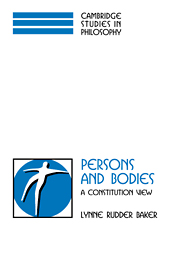Book contents
8 - The Coherence of the Constitution View of Human Persons
Published online by Cambridge University Press: 05 June 2012
Summary
The general idea of constitution-without-identity, as we have just seen, has the resources to meet the charge of incoherence. In this chapter, I want to show that the specific application of the idea of constitution to human persons likewise can meet this charge. The most serious challenge to the Constitution View today comes from those who hold that we are not merely constituted by animals, but that we are identical to animals. It is to such Animalists that I primarily want to respond. I shall begin with a series of objections that have been raised against a ‘coincidence’ view of person and body, and I shall show that, if these objections were taken to apply to the Constitution View, they would seriously mischaracterize the Constitution View as I have developed it. Next, I shall respond to three problems that are thought to attend the denial that I am identical to an animal: the “how many” problem; problem of linguistic incoherence; and the “fetus problem.” Finally, I want to respond to a putative counterexample to the application of the idea of constitution to persons and their bodies.
CONSTITUTION IS NOT MERE “COINCIDENCE”
Eric Olson combats a view according to which I am “associated with” a human animal with which I share the same matter and to which I am not identical. He calls this view “coincidence” and subjects it to a blistering attack. I want to begin with criticisms that Olson aims against “coincidence” to show that if applied to the Constitution View, these criticisms would miss their mark.
- Type
- Chapter
- Information
- Persons and BodiesA Constitution View, pp. 191 - 212Publisher: Cambridge University PressPrint publication year: 2000



